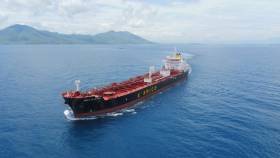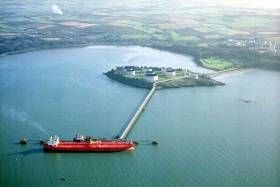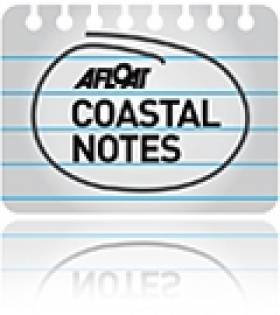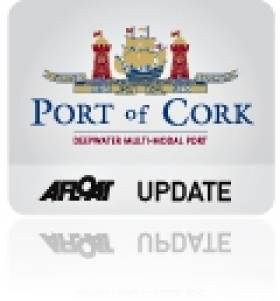Displaying items by tag: Whitegate Oil Refinery
Italian Shipping Giant's Dublin Subsidiary Managed 'Handysize' Tanker Docks in Cork Harbour
#PortofCork - Italian shipping giant d'Amico Società di Navigazione SpA, manages one of the largest bulk, container and product tankers fleets that includes Cielo di New York that is docked at the Whitegate Oil Refinery, Cork Harbour, writes Jehan Ashmore.
As part of d'Amico International Shipping (DIS) the group structure includes the Dublin based d'Amico Tankers Ireland. They manage the Maltese flagged Cielo di New York, a 39,990dwt 'Handysize' product tanker had docked yesterday after a period of anchorage offshore and prior to that a sailing from Mongstad, Norway.
Cielo di New York was built by Hyundai Mipo yard in South Korea in 2014. It is also in this Asian country is where Arklow Spray was constructed. The 33,905dwt Irish flagged bulk carrier had recently called to New York while sister, Arklow Spray sailed across the Atlantic Ocean from Brazil to Cork to discharge a part cargo of animal feed in Ringaskiddy. Following this maiden call to Cork, the bulker also made an inaugural call to Dublin Port to unload the balance of cargo.
A sister of the Italian shipping group, Cielo di Ulsan is also 100% owned by d'Amico International Shipping (DIS) and that had called to the same facility in Cork Harbour last month. The pair are classified with IMO II and IMO III certifications.
The Handysize sisters belong to a fleet ranging in capacity of between 36,000 and 40,000 dwt. With their slightly smaller size compared to Medium Range (MR) vessels, they are suitable for trade on brief routes with numerous port moorings, as they allow rationalization of usage and economic savings as regards port costs.
Generally, Handysize tankers operate in the Baltic Sea, Mediterranean Sea, Black Sea and are also suitable for commercial trade in the Caribbean Sea.
#WhitegateOil – As the Whitegate Oil Refinery in Cork Harbour is the only such strategic facility in the State, Afloat took an opportunity to highlight a tanker berthed at the terminal today, writes Jehan Ashmore.
According to the Port of Cork, one of the berths at the terminal’s jetty is occupied by the Faroese-flagged Fure Fladen. The 18,000dwt tonnes oil/chemical tanker had sailed overnight from an anchorage on Firth of Clyde, Scotland.
In Autumn 2016 a Canadian firm, Irving Oil decided to buy Whitegate from US owners Phillipps 66, and this has ensured security of supply to the market.
Speaking at the official launch by new owners Irving Oil as reported in The Irish Times, the Minister for the Environment Denis Naughten said the Whitegate facility was “crucially important for Ireland”
“It is crucially important from the point of view that this is the only oil refinery on the island of Ireland. It is much easier to access crude oil than processed oils – petrol and diesel. So it is important from a security point of view that we have an oil refinery on the island. It is not just an Irish issue. It is a European issue as well.
The future of the refinery employing 160 had been in doubt, given the 15-year operating licence ran out during last summer.
Acquisition by Irving Oil had allayed local concerns as the company announced it would be operating the plant with its existing full workforce.
The 144m long Fure Fladen is scheduled to depart tomorrow. A next port of call is Eastham where the Mersey meets the lochs entrance to the Manchester Ship Canal.
Sold Whitegate Oil Refinery to Canadian Company
#WhitegateSold - Cork Harbour, the location of the Whitegate oil refinery has been sold to Canadian company Irving Oil, writes the Irish Examiner.
The country’s sole refinery will remain operational and all staff will continue to be employed, according to its new owners.
The sale of the refinery comes after a protracted sales process and the expiration of an obligation on the facility’s previous owner Phillips 66 to operate the refinery until the end of July 2016.
“We are pleased to have signed an agreement to purchase the Whitegate refinery,” says Arthur Irving, Chairman of Irving Oil.
Oil Refinery at Whitegate of ‘Strategic Energy Importance’ to Ireland
#Refinery - The Irish Examiner writes that the Port of Cork is partially “insulated” said its chairman from future developments at Whitegate oil refinery but has a clear preference for it to remain operational.
The refinery’s future continues to hang in the balance as the obligation on its owner Phillips 66 to operate the facility until July 2016 draws closer.
The ongoing uncertainty is cause for concern for the port which counts on Whitegate for 55% of its freight traffic.
The possibility that the refinery would be converted to a storage facility if the “worst-case scenario” came to pass offers some solace regardless of whether Whitegate remains operational, said Port of Cork chairman John Mullins.
To read more from the newspaper's story click here.
Phillips 66 Pulls Out of Sale of Whitegate Oil Refinery
#WhitegateOilRefinery – The Irish Independent writes that the US oil company, Phillips 66 has pulled the sale of Ireland's only oil refinery at Whitegate in Cork as attempts to find a buyer failed.
Last June, Phillips 66 hired Deutsche Bank to help sell the refinery. However, despite smoking out several potential suitors, the company and its advisers were unable to seal a deal.
Phillips 66 will continue to operate the refinery in Cork, although it may seek to offload a nearby storage facility in Bantry Bay. Around 200 staff are employed by Phillips 66 across its Irish operations. For more on the story click HERE
As previously reported on Afloat.ie last year the Government-commissioned a report that said the state did not need its own oil refinery as it can import enough of the fuel to meet all its needs.
For a copy of the report published by the Department of Energy, click HERE.
Ireland Does Not Need Own Oil Refinery
#WhitegateOil – According to a Government-commissioned report published this week, the state does not need to have it own oil refinery as it can import enough of the fuel to meet all its needs.
The news comes as US-based Phillips 66, owner of the country's sole refinery at Whitegate in Cork Harbour, gears up to sell the plant along with a number of its other European operations.
The multinational's decision has thrown a question mark over Whitegate's long-term future, although as it stands anyone who owns the refinery has to keep it operating until at least 2016. The Irish Times has more on this story.
To download a PDF copy of the report Study of the Strategic Case for Oil Refining Requirements on the Island of Ireland, which is available from the Department of Energy, click this LINK.
‘Resilient’ Performance by Port of Cork in 2011
#PORT OF CORK - Port of Cork Company chairman, Mr Dermot O'Mahoney, yesterday announced end of year trade traffic results for the Port of Cork in 2011. He said: "Trade traffic has shown remarkable resilience recording 8.8 million tonnes despite experiencing challenging periods during 2011." These figures are on a par with 2010 figures at the Port of Cork.
A remarkable feature of the figures is the very positive effect on the local economy by the increase in exports from the Port. Total exports at the Port of Cork have remained strong increasing by 9% in comparison to 2010 and by 19% since 2009. Exports are a key driver in the successful recovery of the Irish Economy and the Port of Cork is committed to continuous support in the growth of international trade for both current and future economic prospects.
Although the growth in export volumes to pre –recession levels reflects the rapid "V" shaped bounce back by the export sector which was achieved despite the depressed international economic environment, import volumes are still 12.9% below 2007 levels. The continued low volume of imports is inevitably putting huge strain on the ports, shipping lines and transport sector servicing the country.
The container business at the Port of Cork has shown an increase of 5% with over 150,000 TEU handled in 2011. Animal feed stuffs, fertiliser and other trades have shown a marginal decrease in 2011. Oil traffic has remained steady despite the lower levels of domestic economic activity; however exports of refined product from Conoco Phillips Whitegate Oil Refinery has remained strong and continues to be a significant part of the Port of Cork business.
Remarking on the end of year trade traffic results, Mr Dermot O'Mahoney Chairman of the Port of Cork said: "The Port of Cork is pleased to announce that total trade traffic in 2011 has remained strong with exports increasing by 9% over 2010 volumes. With 98% of all goods imported or exported from Ireland moved by ship, the importance of ports to our economy is of vital strategic importance. The Port of Cork is a key link to the continued economic success of Ireland and in particular the entire Munster region. The challenge now facing the Port of Cork is to continue to develop to meet the needs of the Country as it emerges from this current recession. This requires that we be visionary and seize opportunities presented by emerging trends and logistic supply changes."
He continued: "While the next four to five years will be challenging for us all, we need to continue to promote the fact that Ireland is an excellent investment location and is well placed to capitalise on growing global markets as is evident by our export sector."
53 cruise vessels visited the Port of Cork during 2011 bringing over 100,000 passengers and crew to the region and the Port is scheduled to accommodate 60 vessels in 2012. According to research carried out by UK Consultants GP Wild, the average in-transit spend per passenger, while visiting an Irish port is between €73- €100 which provides a significant contribution towards the local tourism economy. In 2011 the Port of Cork won 1st place for 'Best Destination Experience (Organised)' in the world and 2nd place for 'Best Port Welcome' in the Dream World Cruise Destinations Awards. This achievement highlighted the outstanding team effort and commitment by the Port of Cork to deliver an excellent service to the visiting cruise lines and their passengers when in Cork. Ireland Inc. also received a Commendation as a "Destination where the Quality and Professionalism of Tour Guides is considered outstanding".
Port officials are pro-actively engaged with tourism interests, County and City Councils and destination attractions to enhance the product on offer to the visiting cruise lines with a view to growing the business further through its dedicated cruise terminal.
Ferry passenger numbers with Brittany Ferries remained steady on its weekly ferry service from Cork to Roscoff and the Port awaits the outcome of the Examinership of Fastnet Lines and the re-commencement of the ferry service linking Cork with Swansea.
The Port of Cork's recreational strategy continues to expand with the aim of improving the marine leisure facilities around Cork Harbour.
Mr O' Mahoney concluded by saying that "the Port of Cork must continue to reinforce its existing strength as the primary deep-water port in the south of Ireland and build on our progress so far by effectively resolving our challenges in an imaginative way and with a strong sense of urgency and determination."
Former WW II Oil-Tanker Lays Cables Across Cork Harbour
To read further information about the cable installation project which is listed on the Port of Cork Company website under Notice to Mariners (No. 6 of 2011) click here.
The odd appearance of the barge masks a colourful and chequered career, as only a remnant of the original vessel survives (see photo). Only the forward section and bow (90m long X 20m beam) remain after the partial scrapping of the former oil tanker, Esso København, which took place nearly fifty years ago.
She was launched in 1930 as the MS Peter Hurll by the Palmers Shipbuilding and Iron Company Ltd (Yard/Hull no. 479) at Hebburn-on-Tyne, England. Measuring 11,952grt the tanker was commissioned for Baltisch-Amerik Petroleum Import G.m.b.H. (Waried Tankschiff Rhed.) of Danzig. For further details click here.
The vessel's profile was typical of the era, with a 'two-island' arrangement where the bridge superstructure is sited amidships and separated from the crew's accommodation quarters located aft on the poop deck at the stern.
At 452-foot long, the 17,585dwt vessel had a cargo carrying capacity of 138,108 barrels, which had an assigned pumping rate of 4,000 barrels an hour. The twin-screw diesel powered vessel had 5,300 brake horsepower engines that gave a speed of 12.3 knots.
In 1935 the vessel was sold to the Panama Transport Co. of Panama. While en route to Aruba, with an American crew, war was declared in Europe on September 3, 1939. At the Caribbean island's port of Las Piedras the Peter Hurll loaded her first war-time cargo of 106,514 barrels of fuel and crude oils bound for Everett, Mass.
Throughout the war years the Peter Hurll was crewed at various times between Americans and Danes. To read in greater detail the career history of the vessel and an account of the attempted U-Boat attack on the Peter Hurll click here. The tanker had several sisters, the F. H. Bedford Jr, J. H. Senior, J.A. Mowinckel and The Heinrich v. Riedemann which was lost on April 16, 1942.
Only a few months after the war in February 1946, the Peter Hurll bunkered the Queen Mary, which was moored alongside Pier 90 on the North River, New York. In less than 10 hours the vessel tranferred 27,797 barrels of fuel in a direct tanker-to-ship delivery of fuel oil. The famous 80,000 tonnes Cunard liner which like the tanker, was also built in 1930, had been recently re-converted from a troopship to her peacetime role as a passenger-liner.
In 1967 the liner retired and the vessel is moored at Long Beach, California, as a static hotel, restaurant and museum (see www.queenmary.com).
Two years later the Peter Hurll changed ownership to Det Danske Petroleums A/S of Copenhagen but later under the control of Dansk Esso A/S was renamed Esso København (see link) and the vessel was enlarged to a tonnage of 12,043grt.
In 1952, the vessel was taken to Odense, Denmark by H. J. Hansen, where the vessel was partially broken-up. The remaining fore-end survived and was rebuilt as a cable / pipe laying barge in 1963 (click here). The structure which essentially is a barge was named Henry P Lading for new owners, Nordisk Kabel og Traadfabrikker A/S, Copenhagen.
At one stage the barge was renamed "Nkt Cables a/S" but in 2002 the barge was sold to Jydsk Dykkerfirma ApS, now named JD Contractor A/S. The company (click here) is the largest underwater contractor in Denmark, providing diving assignments and the laying and embedding of submarine cables and pipelines worldwide.
Only late last year, scuba-divers found a fully intact World War I U-Boat on the seabed just outside Cork harbour. To read more about the U-Boat which sank some 93 years ago and photos click here.



































































